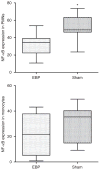Acute removal of common sepsis mediators does not explain the effects of extracorporeal blood purification in experimental sepsis
- PMID: 21918497
- PMCID: PMC3269547
- DOI: 10.1038/ki.2011.320
Acute removal of common sepsis mediators does not explain the effects of extracorporeal blood purification in experimental sepsis
Abstract
The effect of extracorporeal blood purification on clinical outcomes in sepsis is assumed to be related to modulation of plasma cytokine concentrations. To test this hypothesis directly, we treated rats that had a cecal ligation followed by puncture (a standard model of sepsis) with a modest dose of extracorporeal blood purification that did not result in acute changes in a panel of common cytokines associated with inflammation (TNF-α, IL-1β, IL-6, and IL-10). Pre- and immediate post-treatment levels of these cytokines were unchanged compared to the sham therapy of extracorporeal circulation without blood purifying sorbent. The overall survival to 7 days, however, was significantly better in animals that received extracorporeal blood purification compared to those with a sham procedure. This panel of common plasma cytokines along with alanine aminotransferase and creatinine was significantly lower 72 h following extracorporeal blood purification compared to sham-treated rats. Thus, the effects of this procedure on organ function and survival do not appear to be due solely to immediate changes in the usual measured circulating cytokines. These results may have important implications for the design and conduct of future trials in sepsis including defining alternative targets for extracorporeal blood purification and other therapies.
Conflict of interest statement
JAK is a paid consultant for CytoSorbents. All the other authors declared no competing interests.
Figures







Comment in
-
Extracorporeal therapy in sepsis: are we there yet?Kidney Int. 2012 Feb;81(4):336-8. doi: 10.1038/ki.2011.375. Kidney Int. 2012. PMID: 22289793
References
-
- Angus DC, Linde-Zwirble WT, Lidicker J, et al. Epidemiology of severe sepsis in the United States: analysis of incidence, outcome, and associated costs of care. Crit Care Med. 2002;29:1303–1310. - PubMed
-
- Vincent JL, Sakr Y, Sprung CL, et al. Sepsis in European intensive care units: results of the SOAP study. Crit Care Med. 2006;34:344–353. - PubMed
-
- Bone RC. The pathogenesis of sepsis. Ann Intern Med. 1991;115:457–467. - PubMed
-
- Riedemann NC, Guo RF, Ward PA. Novel strategies for the treatment of sepsis. Nat Med. 2003;9:517–524. - PubMed
-
- van der Poll T, Van Deventer SJ. Cytokines and anticytokines in the pathogenesis of sepsis. Infect Dis Clin North Am. 1999;13:413–426. - PubMed
Publication types
MeSH terms
Substances
Grants and funding
LinkOut - more resources
Full Text Sources
Other Literature Sources
Medical

